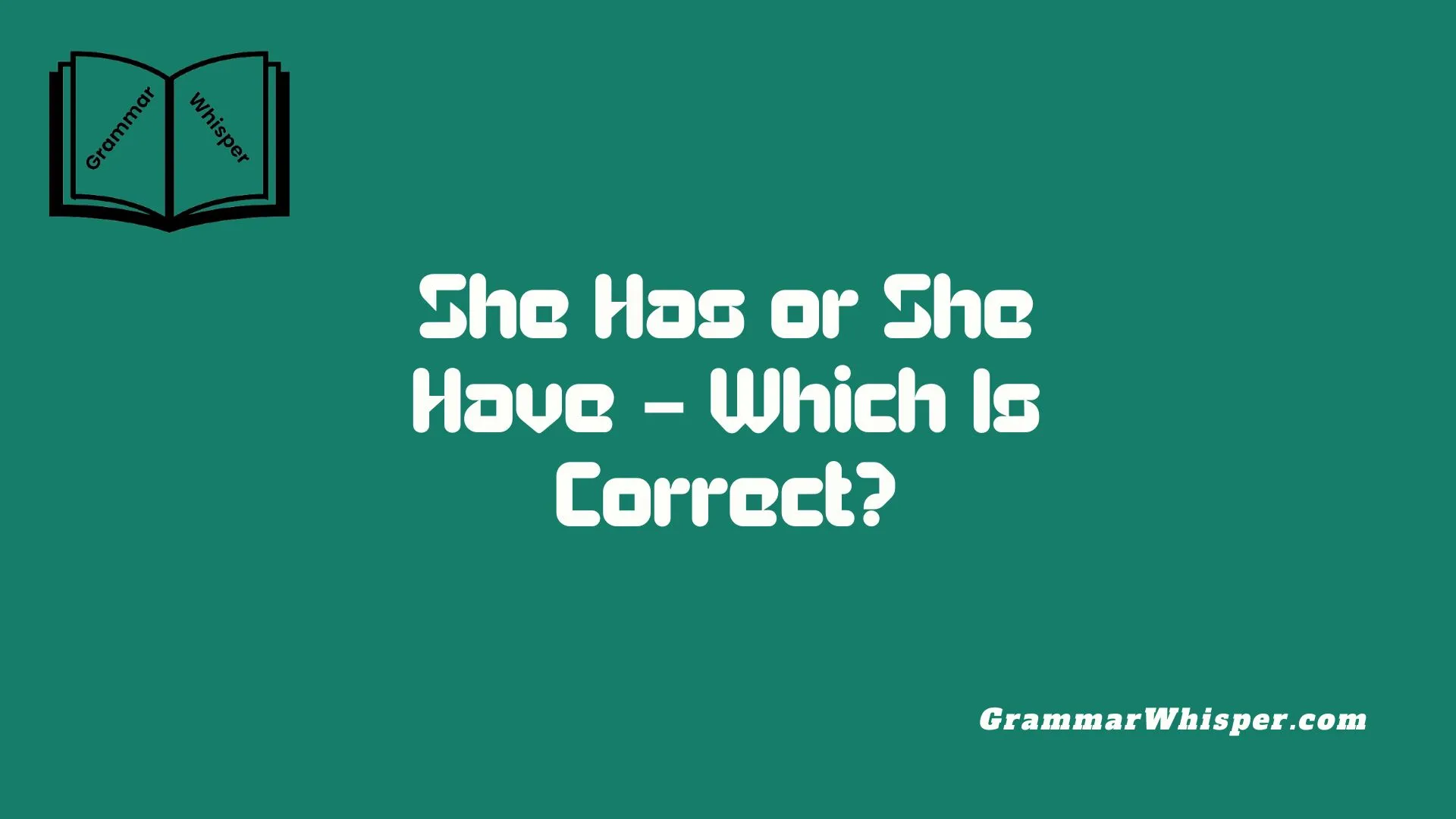Many people often make mistakes with has and have, whether in casual chats, formal writing, or professional emails. From my experience, these errors can shake your confidence and even confuse readers, especially when the subject-verb agreement – a fundamental rule of English grammar – is not followed. One small slip can disrupt the rhythm of your message, no matter how polished or correct it seems.
To sound natural, it’s essential to truly grasp how this part of grammar works. Choosing between “She Has or She Have” depends on understanding this clearly. This quick guide offers the right tools to help you use these phrases flawlessly in any situation. When you get this down solidly, you’ll find your words flow with ease, and you’ll speak and write more confidently, avoiding common trips that many learners face.
The Core Grammar Rule: Subject-Verb Agreement Simplified
At the heart of the “she has” vs “she has” debate is subject-verb agreement. This means the verb in a sentence must match its subject in number (singular or plural) and person (first, second, or third).
- “She” is a third-person singular pronoun.
- Singular subjects use verbs that end differently from plural subjects in the present tense.
In simple terms:
- Singular subjects (he, she, it) take “has”.
Plural subjects (we, they) take “have”.
Here’s a quick table for reference:
| Subject | Correct Verb Form | Example Sentence |
| I | have | I have a book. |
| You | have | You have a car. |
| He / She / It | has | She has a meeting today. |
| We | have | We have lunch at noon. |
| They | have | They have finished work. |
Breaking Down “Has” and “Have”
Understanding these two verbs starts with their roles and forms:
- “Has” is the third-person singular present tense of “have.” It shows possession, relationships, or characteristics. Example: She has blue eyes.
- “Have” is the base form, used with I, you, we, and they in the present tense. It also serves as an auxiliary verb in perfect tenses and modal verb phrases. Example: They have two dogs.
When to Use “Has” vs “Have”
- Use “has” with singular third-person subjects like she, he, it, or singular nouns (the cat, the company).
- Use “have” with plural subjects or the pronouns I, you, we, and they.
- Use “have” as an auxiliary verb following modal verbs (can, should, could, might).
“She Has” – The Correct Form Explained
When you talk about something belonging to “she” or describe an action or state involving “she,” you use “she has.” This is standard and non-negotiable in the present simple tense.
Examples of “She Has” in Sentences
- She has a beautiful voice.
- She has finished her homework.
- She has a meeting this afternoon.
Notice how “has” agrees perfectly with “she,” showing the third-person singular form.
When “Have” Is Correct with “She”
Here’s where things get tricky. You never say “she has” as a standalone present-tense. However, “have” appears in perfect tenses and modal verb constructions.
Modal Verbs + Have
After modal verbs like should, could, would, might, must, the base form “have” always follows – no exceptions.
- She should have called by now.
- She could have won the race.
- She might have forgotten.
These phrases express possibility, necessity, or hypothetical situations. Using “she should have” or “she could have” is incorrect and sounds unnatural.
Perfect Tenses with “She Has”
In the present perfect tense, “she has” combines with past participles to show completed actions.
- She has traveled to France.
- She has seen that movie.
In perfect tense constructions, “has” is still the correct verb, not “have.”
Common Mistakes to Avoid
Mistakes often stem from mixing verb forms or misunderstanding modal verbs. Here are the top ones to watch out for:
- Wrong: She has a car.
- Right: She has a car.
- Wrong: She should have done it.
- Right: She should have done it.
- Wrong: Shehase finished her work.
- Right: She has finished her work.
Keep in mind, “have” only follows “she” after modal verbs (should, could, might), never as a main verb in present simple tense.
Collective Nouns, Names, and Proper Nouns: What About Them?
Understanding how collective nouns and proper nouns behave helps clear confusion about “has” and “have” in specific contexts.
Collective Nouns
Collective nouns refer to groups acting as a single unit (team, family, company).
- The team has won the championship. (Singular – treated as one unit)
- The teams have signed up for the tournament. (Plural)
When a collective noun is singular, use “has.” For plural groups, use “have.”
Names and Proper Nouns
Singular proper nouns take “has”. For example:
- Jessica has a new job.
- The company has expanded its operations.
If referring to plural proper nouns (e.g., multiple companies), use “have.”
Perfect Tenses: Navigating “Has” and “Have” in Context
Perfect tenses use “have” or “has” plus a past participle to express actions related to the past, present, or future.
| Tense | Example with “She” |
| Present Perfect | She has completed her project. |
| Past Perfect | She had finished before noon. |
| Future Perfect | She will have arrived by 5 PM. |
Remember, “has” is for third-person singular in present perfect, while “have” appears with plural subjects or auxiliaries.
Idiomatic Expressions and Common Phrases with “Has”
Some idioms and common phrases feature “has” prominently. Recognizing these helps you sound natural and fluent.
- She has a chip on her shoulder, meaning she’s easily angered or resentful.
- She has a heart of gold, meaning she’s very kind.
- She has her head in the clouds – meaning she’s dreamy or distracted.
Using “have” instead would sound awkward in these expressions.
Quick Tips and Tricks to Get It Right Every Time
Here are handy tips to avoid mistakes:
- Tip 1: If your subject is she, he, or it, use “has” as the main verb.
- Tip 2: After modal verbs like should, could, and would, always use the base verb “have.”
- Tip 3: When in doubt, identify the subject’s number and person first.
- Tip 4: Use tables or lists to memorize verb forms with subjects.
- Tip 5: Read your sentence aloud – if it sounds off, double-check the verb form.
Practice Section: Test Your Knowledge
Try filling in the blanks with “has” or “have.”
- She ___ been working all day.
- They ___ finished their homework.
- He should ___ called you earlier.
- My sister ___ a new car.
- We ___ seen that movie twice.
Answers: 1. has, 2. have, 3. have, 4. has, 5. have
Conclusion
Using “she has” and “she has correctly is about understanding basic grammar rules and applying them with confidence. Remember:
- “She has” is your go-to in the present simple tense for singular third-person subjects.
- “She has” is never correct alone, but “have” follows modals (should have, could have).
- Pay attention to collective nouns and proper nouns.
- Practice regularly to make it second nature.
Master these rules, and you’ll never second-guess your sentences again!
Helpful Resources
- Purdue OWL: Subject-Verb Agreement
- Grammarly Blog: Have vs. Has
FAQs:
Is “she has” ever correct?
In standard English grammar, “she has is not correct as a main verb. You should always use “she has” for third-person singular subjects. However, “have” follows modal verbs (like should, could, might), e.g., “she should have.”
Why do we say “she has” and not “she has”?
Because “has” is the correct third-person singular form of the verb “have” in the present tense, matching the singular pronoun “she.” “Have” is used with plural subjects or with “I” and “you.”
Can I say “she has” in informal speech?
While some dialects or informal speech might occasionally use “she has,” it is considered grammatically incorrect in standard English and should be avoided in writing and formal speaking.
How do modal verbs affect the use of “have” with “she”?
After modal verbs like should, could, would, might, must, the base form “have” always follows regardless of the subject. For example: “She should have gone,” not “She should have one.”
What about collective nouns like “team” or “family”? Do I use “has” or “have”?
Use “has” when the collective noun is treated as a single unit (The team has won). Use “have” when the noun is considered plural or referring to individual members (The team has different opinions).











